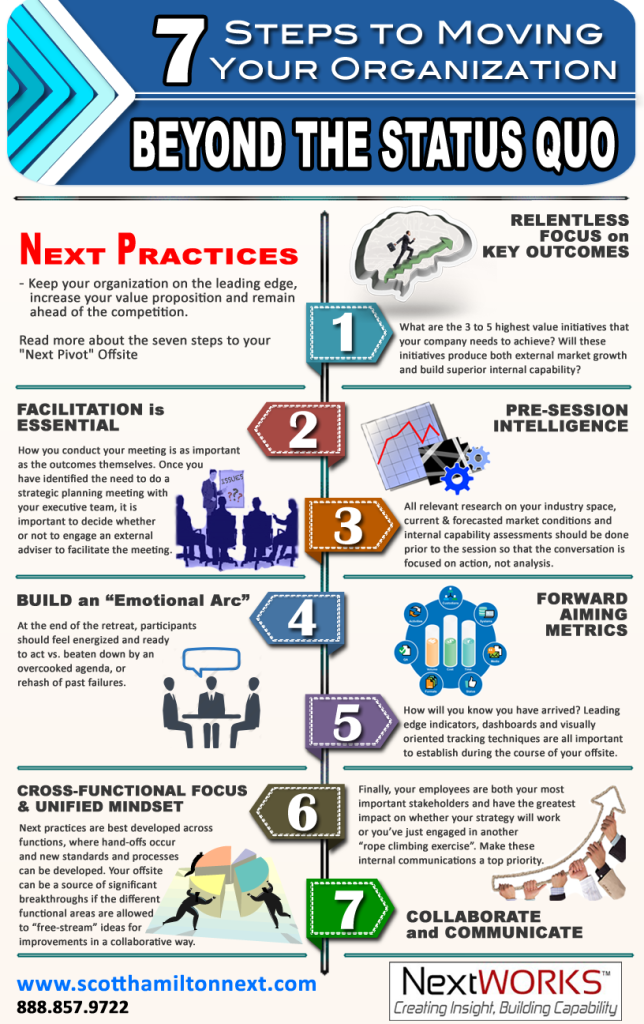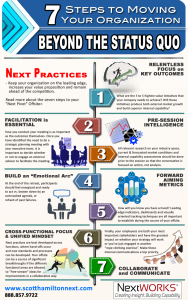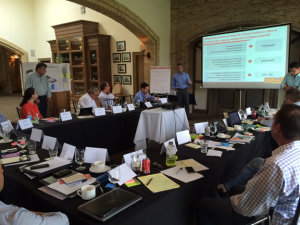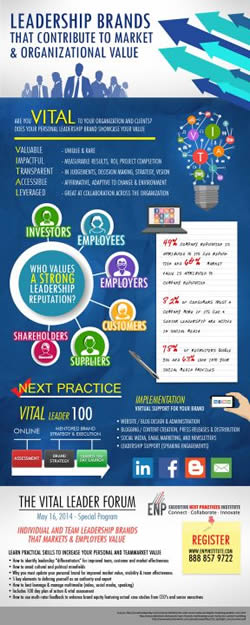Three months into 2015, how well is your team prepared to adapt, focus, and deliver results that will carry your organization forward? How ready are you to capture new business in a revived and hyper competitive marketplace? Chances are, if you approach your strategic, brand and operational planning the same way you’ve done it in the past, you are likely to wind up with the same status quo results.
Business planning, strategic sessions, team building and project plans all have one thing in common- they have an increasingly short relevance and viability in today’s markets. A new approach- focused on value, adaptability, innovation and sustained results for all stakeholders is called for.
Perhaps you’ve decided to meet as an executive or departmental team to recast or update your strategy for 2015. Congratulations, now the key question- how do you design an effective, engaging session given the urgency and need for insight, alignment and quantifiable outcomes?
Here are 7 “next practices” for a “re-launch” of your team in 2015:
- A Relentless Focus on the “Mountaintop”
 Vision is great, absolute clarity of what success will look like when you arrive is even better.
Vision is great, absolute clarity of what success will look like when you arrive is even better.
What are the 3 to 5 highest value initiatives that your company needs to achieve? Will in fact these initiatives produce both external market growth and build superior internal capability? This will allow you to focus on the things that truly matter and prevent you from being sidetracked or overwhelmed by too many “priorities”.
What is the “burning platform” or market imperative that drives the need for a strategic update? A cross functional representation of your key leadership should weigh in on your agenda planning to finalize the meeting scope, length and final participants.
- Market and Operational Intelligence
All relevant research on your industry space, current & forecasted market conditions and internal capability assessments should be done prior to your strategy session so that the actual meeting is focused on action, not analysis.
Your 100 day strategy agenda should contain a comprehensive list of topics to be discussed as well as a brief on external speakers. Feedback should be solicited from all members who will participate. The feedback is often gathered in a pre-offsite interview with the session facilitator and designed to anonymous.
- Hire a Professional Facilitator
 How you conduct your meeting is almost as important as the outcomes themselves. Once you have identified the need to do a strategic planning meeting with your executive team, it is important to decide whether or not to engage an external adviser to facilitate the meeting.
How you conduct your meeting is almost as important as the outcomes themselves. Once you have identified the need to do a strategic planning meeting with your executive team, it is important to decide whether or not to engage an external adviser to facilitate the meeting.
Internal (employee) facilitators often have an advantage of knowing the company and key players well, but may not have the position power, be limited politically and/or have a limited strategic skill set. Even if they have all three attributes, many internal experts often prefer to remain neutral and be part of the offsite experience as opposed to facilitating it.
You may instead want the objectivity of a professional strategic adviser to keep the meeting moving forward, overcome conflicts, and recognize/help the group pivot when necessary. A good facilitator is not only an expert at strategic planning, but they know how to manage the session “flow”, group dynamics, energy levels and when to limit or extend strategic discussions.
- Build an “Emotional Engagement Arc”
Strategic planning sessions and executive retreats can be an extraordinary venues for collaboration among the members of your executive team in your pursuit to achieve a purpose. Hence, limit the number of formal, elaborate PPT presentations during the retreat to allow more time for your participants to share their insights and exchange ideas with each other.
Just like a stage play, a retreat should have an emotional arc. Typically, you would want to have a lower level of emotional engagement in the early stages as the issues and environment are explored, building to a fully engaged, passionate discussion of the issues and potential solutions as key strategic initiatives are identified. At the end of the retreat, participants should feel energized and ready to act vs. beaten down by an overcooked agenda, or rehash of past failures.
- Leading and Milestone Metrics
How will you know you have arrived? Leading edge indicators, dashboards and visually oriented tracking techniques are all important to
establish during the course of your offsite. These are generally supported by clear project plans with owners and timetables. Additionally, goals and objectives should follow the SMART criteria (Specific, Measurable, Actionable, Realistic and Time-based)
- “Break it” for Breakthroughs
 “Next practices” are best developed across functions, where hand-offs occur and new standards and processes can be developed. No company can progress if they remain in siloed thinking. Your offsite can be a source of significant breakthroughs if the different functional areas are allowed to “free-stream” ideas for improvements in a collaborative way.
“Next practices” are best developed across functions, where hand-offs occur and new standards and processes can be developed. No company can progress if they remain in siloed thinking. Your offsite can be a source of significant breakthroughs if the different functional areas are allowed to “free-stream” ideas for improvements in a collaborative way.
It means having the courage to confront and “break” legacy systems, behaviors and practices. Additionally, we have seen several CEOs literally extend a session until they were sure that they had a unified mindset among all team members to the mission, vision and key strategic initiatives developed during the retreat. Not consensus, but a genuine overall agreement to the best direction to follow at this time, knowing that a pivot in direction may be necessary in the future.
- Communicate, Mitigate Risk & Align
Changes and new strategic directions developed during the strategic planning session often give birth to several potential risks. You and your executives must be on the same page on how you will manage all the risks that comes with the changes.
The participants of your strategic planning session are your best project leaders and champions in implementing and communicating the changes. Therefore, before you end the strategic planning meeting, an essential step is to secure the commitment of your management team in adopting and owning the changes agreed upon during the sessions.
Finally, your employees are both your most important stakeholders and have the greatest impact on whether your strategy will work or…you’ve just engaged in another “rope climbing exercise”. Make these internal communications a top priority. We have frequently seen the effective use of alignment “maps” deployed to communicate strategy.
We wish you the best of success in 2015 and beyond.



 It is an effective practice to send the offsite agenda days, if not weeks in advance of the scheduled retreat. The program should contain a comprehensive list of topics to be discussed as well as a brief on external speakers. Feedback should be solicited from all members who will participate. The feedback is often gathered in a pre-offsite interview with the session facilitator and can be structured as a confidential conversation to ensure maximum candor concerning both business and team effectiveness issues.
It is an effective practice to send the offsite agenda days, if not weeks in advance of the scheduled retreat. The program should contain a comprehensive list of topics to be discussed as well as a brief on external speakers. Feedback should be solicited from all members who will participate. The feedback is often gathered in a pre-offsite interview with the session facilitator and can be structured as a confidential conversation to ensure maximum candor concerning both business and team effectiveness issues.



